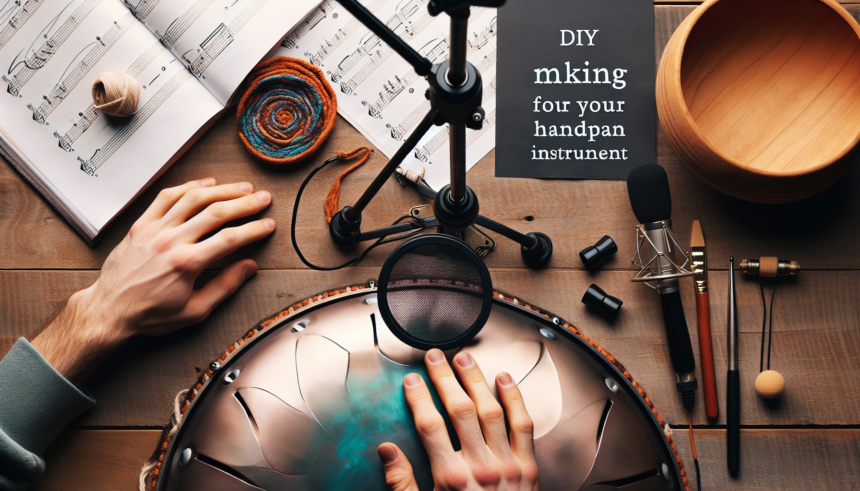Miking a handpan, a unique and enchanting musical instrument, can be a daunting task, especially if you’re new to sound recording. The handpan, with its rich, resonant tones, requires a nuanced approach to capture its full, intricate sound profile accurately. This article aims to guide you through some do-it-yourself (DIY) tips for effectively miking your handpan instrument, ensuring that you get the best possible sound quality.
Understanding the Handpan’s Sound Characteristics
Before diving into the specifics of miking, it’s essential to understand the unique sound characteristics of the handpan. The handpan produces a wide range of frequencies, from low, throbbing bass notes to high, shimmering overtones. Its sound can be both percussive and melodic, requiring microphones that can capture this dynamic spectrum without distortion or loss of detail.
Choosing the Right Microphone
The first step in miking your handpan is selecting the right microphone. Here are some factors to consider:
- Condenser Microphones: These are typically more sensitive than dynamic microphones and can capture a broader frequency range, making them a preferred choice for recording the handpan.
- Directional Patterns: Microphones come with different directional patterns, such as cardioid, omnidirectional, and bidirectional. For handpans, a pair of small-diaphragm condenser microphones in an XY or ORTF configuration can effectively capture the instrument’s stereo image and depth.
- Quality and Budget: While high-quality microphones can be expensive, there are budget-friendly options that perform admirably. Brands like Audio-Technica, Rode, and AKG offer microphones that provide excellent sound quality without breaking the bank.
Positioning Your Microphones
Proper microphone placement is key to capturing the best sound from your handpan. Here are some tips on positioning your microphones:
- Start with Stereo Pair: Place a stereo pair of small-diaphragm condenser microphones above the handpan. An ideal starting point is around 1 to 2 feet above the instrument, angled slightly towards each other to create a stereo image.
- Experiment with Angles: Slightly adjusting the angle and distance of the microphones can significantly impact the sound. Experiment with different positions to find the sweet spot that captures the full body and richness of the handpan.
- Consider Additional Mics: To capture more ambient sound and enhance the recording, consider adding an omnidirectional microphone placed at a distance of about 3 to 5 feet from the handpan. This can add depth and natural reverb to your recording.
Setting Up Your Recording Space
The environment in which you record plays a significant role in the sound quality. Here are some tips for setting up your recording space:
- Reduce Reflections: Hard surfaces can cause unwanted reflections and echoes. Use acoustic panels, rugs, or curtains to minimize reflections and create a more controlled recording environment.
- Minimize Noise: Choose a quiet location where you can avoid background noise. Turn off any electronic devices not needed for recording to reduce hum and interference.
- Use a Proper Stand: Ensure your handpan is mounted on a stable stand or surface that doesn’t create unwanted vibrations or noise. This will help in achieving a clean recording.
Optimizing Your Recording Levels
Managing your recording levels is crucial for preventing distortion and ensuring a clean, dynamic recording. Here’s how to optimize your levels:
- Gain Staging: Set the gain on your audio interface or mixer to a level where the loudest peaks of your handpan playing don’t clip. Aim for peaks around -6dB to -3dB to provide headroom.
- Monitor Levels: Use headphones or studio monitors to carefully listen to your recording in real-time. This allows you to make immediate adjustments to avoid distortion or undesired noise.
- Record Multiple Takes: Playing different takes gives you more options during the mixing stage. You can choose the best parts from each take to create the perfect recording.
Post-Recording Tips
Once you’ve successfully recorded your handpan, the next step is to polish the recording with some post-production techniques:
- EQ (Equalization): Use EQ to balance the frequencies captured in your recording. Gently boost the high frequencies to add shimmer and clarity, and attenuate any overly boomy low frequencies.
- Compression: Apply subtle compression to even out the dynamic range without squashing the natural dynamics of the handpan. A ratio of 2:1 to 4:1 is a good starting point.
- Reverb: Adding a touch of reverb can enhance the handpan’s natural acoustic environment. Use a room or hall reverb with a short decay time to maintain the instrument’s clarity and presence.
Troubleshooting Common Issues
Sometimes, recordings don’t turn out as expected. Here are some common issues and how to troubleshoot them:
- Unwanted Noise: If you hear background noise, try different microphone placements or move to a quieter environment. Using a noise gate plugin can also help reduce low-level hums and noises.
- Distortion: If your recording sounds distorted, reduce the gain on your audio interface or mixer. Ensure you’re not overloading your microphones or preamps.
- Thin Sound: If your recording sounds thin or lacks depth, experiment with different microphone positions. Adding a bit of bass in the EQ can also help enhance the fullness of the sound.
Conclusion
Capturing the serene and complex sounds of the handpan can be immensely rewarding, bringing its intricate tonal qualities to life in a recording. By carefully selecting your microphones, positioning them correctly, optimizing your recording space, and fine-tuning your audio levels, you can achieve professional-quality recordings even with a DIY setup. Remember, experimentation is key—don’t be afraid to try different techniques until you find what works best for your handpan and personal style. Happy recording!
Frequently Asked Questions (FAQs)
-
Q: What is the best type of microphone for recording a handpan?
A: Small-diaphragm condenser microphones are generally recommended for capturing the broad frequency range and detailed sound of a handpan.
-
Q: How should I position my microphones for recording a handpan?
A: Start with a stereo pair of microphones placed 1 to 2 feet above the handpan and angled towards each other. Adjust the position to find the best sound.
-
Q: How can I reduce background noise in my handpan recordings?
A: Use acoustic panels, position your recording setup in a quiet environment, and ensure all unnecessary electronic devices are turned off.
-
Q: What are some post-production tips for handpan recordings?
A: Use EQ to balance frequencies, apply subtle compression to manage dynamic range, and add a touch of reverb to enhance the natural sound.
-
Q: What should I do if my recording sounds distorted?
A: Reduce the gain on your audio interface or mixer and ensure your microphones and preamps are not overloaded.





